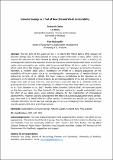Files in this item
Genuine savings as a test of New Zealand weak sustainability
Item metadata
| dc.contributor.author | Qasim, Mubashir | |
| dc.contributor.author | Oxley, Les | |
| dc.contributor.author | McLaughlin, Eoin | |
| dc.date.accessioned | 2019-06-15T23:41:27Z | |
| dc.date.available | 2019-06-15T23:41:27Z | |
| dc.date.issued | 2018-06-16 | |
| dc.identifier.citation | Qasim , M , Oxley , L & McLaughlin , E 2018 , ' Genuine savings as a test of New Zealand weak sustainability ' , Environment, Development and Sustainability , vol. First Online . https://doi.org/10.1007/s10668-018-0185-0 | en |
| dc.identifier.issn | 1573-2975 | |
| dc.identifier.other | PURE: 253428318 | |
| dc.identifier.other | PURE UUID: 6d4980e6-38a1-43cf-95fa-dde2e1546415 | |
| dc.identifier.other | Scopus: 85048593946 | |
| dc.identifier.other | WOS: 000527117600006 | |
| dc.identifier.uri | https://hdl.handle.net/10023/17903 | |
| dc.description | The funding was provided by the New Zealand Marsden Fund. | en |
| dc.description.abstract | The key aims of this paper are to: (1) to extend the World Bank’s (WB) measure of genuine savings (GS) for New Zealand by using a longer time series of data, 1950–2015; (2) improve GS estimates for New Zealand by adding additional dimensions to GS, i.e. forestry; (3) investigate the relationship between several GS measures and the discounted values of GDP per capita and consumption per capita, used to proxy well-being; (4) test a series of hypotheses which relate GS to the change in future well-being using the framework proposed by Ferreira et al. (World Bank Econ Rev 22(2):233–248, 2008. https://doi.org/10.1093/wber/lhn008) and (5) investigate the effects of a growing population on the availability of future capital stocks by considering the consequences of “wealth-dilution” as defined by Ferreira et al. (2008). The paper makes a contribution to the literature on GS, particularly in the context of New Zealand, by considering patterns of GS and well-being over a longer time span of data than have been previously used and add to a relatively small, but growing literature on tests of GS using long or relatively long time-series data [see, e.g. Greasley et al. (J Environ Econ Manag 67(2):171–188, 2014. https://doi.org/10.1016/j.jeem.2013.12.001, Environ Dev Econ 22:674–98, 2017) and Hanley et al. (Enviro Resour Econ 63(2):313–338, (2016). https://doi.org/10.1007/s10640-015-9928-7]. We conclude, based on the data used here, that New Zealand’s GS has been positive (i.e. weakly sustainable), since the start of our data series, even without allowing for the contribution of technological advancement. However, we also conclude that the effects of a growing population and a savings gap have led to a “wealth-dilution” effect needed to maintain real wealth per capita, as we estimate that there was an average savings gap (GS as a percentage of gross national savings) over the period 1955–2015 of 0.5% per annum. | |
| dc.format.extent | 39 | |
| dc.language.iso | eng | |
| dc.relation.ispartof | Environment, Development and Sustainability | en |
| dc.rights | © Springer Science+Business Media B.V., part of Springer Nature 2018. This work has been made available online in accordance with the publisher’s policies. This is the author created, accepted version manuscript following peer review and may differ slightly from the final published version. The final published version of this work is available at https://doi.org/10.1007/s10668-018-0185-0 | en |
| dc.subject | Sustainability | en |
| dc.subject | Genuine savings | en |
| dc.subject | Natural capital | en |
| dc.subject | Hartwick rule | en |
| dc.subject | New Zealand | en |
| dc.subject | G Geography (General) | en |
| dc.subject | HG Finance | en |
| dc.subject | 3rd-DAS | en |
| dc.subject.lcc | G1 | en |
| dc.subject.lcc | HG | en |
| dc.title | Genuine savings as a test of New Zealand weak sustainability | en |
| dc.type | Journal article | en |
| dc.description.version | Postprint | en |
| dc.contributor.institution | University of St Andrews. School of Geography & Sustainable Development | en |
| dc.identifier.doi | https://doi.org/10.1007/s10668-018-0185-0 | |
| dc.description.status | Peer reviewed | en |
| dc.date.embargoedUntil | 2019-06-16 |
This item appears in the following Collection(s)
Items in the St Andrews Research Repository are protected by copyright, with all rights reserved, unless otherwise indicated.

